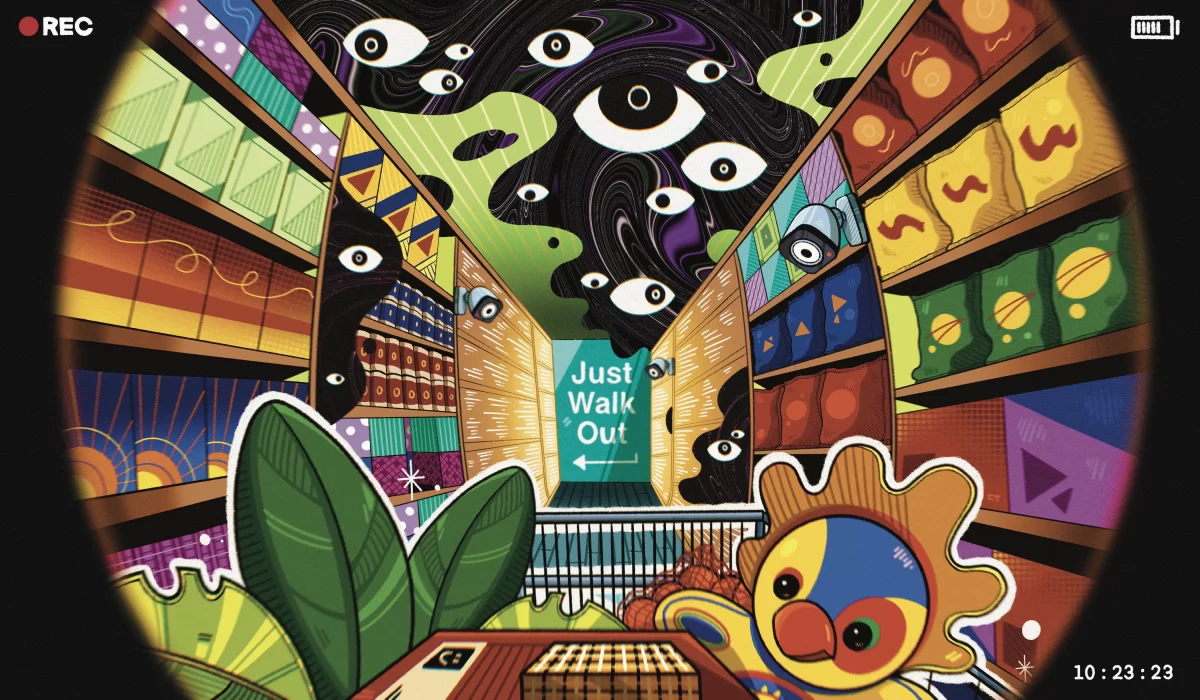UCSD renovated the Sixth, Seventh, and Rogers Markets using Amazon’s JustWalkOut technology, allowing for speedier checkout. However, the functionality of this new technology has raised concerns from some students.
After a three-month construction project, UC San Diego opened the newly renovated Sixth, Seventh and Rogers Markets. Decked out with new shelves, entry and exit gates, and plenty of cameras, the markets’ redesigns are using Amazon’s JustWalkOut technology. The aim of the technology is to cut down wait times upon checkout, allowing sensors and AI to act as cashiers in place of market staff, who can instead focus on aiding shoppers or restocking shelves.
Students may enter the markets by scanning their Triton2Go mobile app or their credit card. The gates open, and anyone who passes through the gates before they close enters upon the scanned student’s tab, allowing shoppers to pair their purchases. Students are then linked to a card and scanners use surveillance technology to track which items they pick up throughout the store.
Efficiency is the driving force behind these updates. Jeff Palmer, senior director of campus dining, considers the renovation a success, citing a 14% increase in students served per day in the new school year.
“In prior years, a student could wait in line up to 15 minutes during peak service times to check out at the register,” Palmer said. “Now, it takes less than a minute to enter the store and there is no line upon exit.”
Alexandra Mirman, a Sixth College sophomore, expressed her support for the market update.
“I guess I prefer it this way, just because it’s faster,” she said. “Sometimes if I’m between classes trying to grab a snack, it’s easier when I know there’s not going to be a long line that I have to wait in.”
Lauren Reyes, a Sixth College junior, questioned this notion, saying that she’d seen a line trailing outside of Sixth Market solely to enter.
“Even though the lines were long in the market sometimes, at least it was inside and it wasn’t causing too much traffic,” she said. “Now it can block out people’s walkways, and that just seems so inconvenient.”
It is possible that this delay is temporary, and only due to students adjusting to the new system. Though market staff assist students in loading their apps and understanding the gate systems, some students have found it difficult to adjust.
“It was really confusing at first,” Alexandra Mirman said, citing the slow loading of the Triton2Go app as part of the difficulty. “Everyone was just standing in the front, trying to figure out how to load it in their apps.” Once Mirman learned the system, however, she expressed support for it, saying it was “cool.”
Technological concerns relating to the new system have been common among students. Struggles with the app loading, phones running out of battery, and on-campus Wi-Fi connectivity issues were mentioned the most among students interviewed. Students have also raised concern over the technology’s dependence on the Triton2Go app, especially following an outage on Sept. 28.
Additionally, some students expressed concerns about the successfulness of the AI to properly detect what is being purchased. Alexandra Mirman mentioned hearing about people being charged for grabbing an item off a higher shelf for a shorter shopper. Her brother, Zach Mirman, a freshman at Seventh College, mentioned getting charged for an item he didn’t buy.
“It was tomato sauce or something? I didn’t even see tomato sauce,” he said, adding that the stray charge was eliminated with ease.
Julia Dimino, a junior at Sixth College, discussed her worries about the system pairing shoppers’ tabs when they enter the gates together.
“Those gates are open for a hot minute, and there really is no way for you to close it,” she said. Despite the presence of market workers, Dimino noted the impossibility of determining which shoppers are intentionally pairing and which ones might be sneaking onto someone else’s tab.
“They don’t know who’s with you or who’s not,” Dimino said. “I mean, how could they?”
Alexandra Mirman shared an opposite concern, recalling one time she was “stuck in the market.” The gates wouldn’t open for her to leave, and she had to call on a staff member to help her exit.
Reyes mentioned difficulty entering the market in the first place due to a fund issue. The new gate systems require a minimum fund of $20 to enter the market, which poses issues with spending rollover dining dollars from the previous year.
“It’s kinda frustrating for people who do have enough to actually buy something, they just can’t get in to actually buy anything with it,” Reyes said.
Students also shared concerns over the mystery of what happens if they overspend. Receipts are only given out several hours after checkout, which Dimino argued made it much more difficult to track her spending.
“You’re not told a number until it’s after the fact,” she said. “If I spend too much, I’m not told a number so I can go put something back real quick.” Dimino also noted an increase in the price of market items, which surprised her the first time she saw her receipt.
The market’s atmosphere has changed notably as well. Students report discomfort with the number of cameras lining the ceilings of these marketplaces.
“If you look up, there’s a bunch of cameras and it’s kind of unnerving,” Zach Mirman commented. “But if you don’t look at it, you won’t really notice it.”
Dimino expressed discomfort with the market the way it is now. “It feels really weird. It feels dystopian.”
The markets have changed in many ways following the remodel, but plenty of things have also stayed the same. Housing Dining Hospitality assured the student body that student jobs were not impacted by the revisions to the markets, and the stock of the market has remained largely unchanged.
“The new market is fine,” Alexandra Mirman said, “it just takes a lot of getting used to for people who went to the old market very often.”
Reyes, on the other hand, misses what the market once was.
“I miss the vibe of the old market. I go there not only to get stuff but also for the experience,” Reyes added. “I enjoyed the idea that there were people waiting to scan your items and talk to you. It feels much more vending machine-like now.”
Zach Mirman expressed his thought most succinctly: “It mostly just feels like a normal grocery store, I guess. Nothing special about it.”
For students without an attachment to the old market, the new remodel may seem trivial. To those who were used to browsing items daily alongside friends, the mechanization of the market’s charming qualities may seem like a betrayal.





















